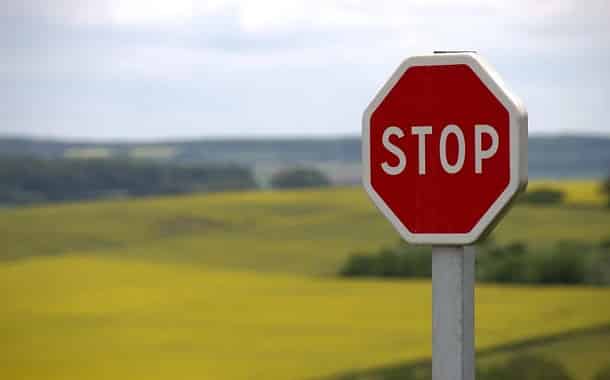How Much Does a Stop Sign Cost?
Last Updated on April 2, 2024
Written by CPA Alec Pow | Content Reviewed by ![]() CFA Alexander Popinker
CFA Alexander Popinker
Stop signs are an essential piece of traffic control infrastructure, helping to regulate vehicle and pedestrian flow and enhance safety at intersections and crossings. But like any municipal investment, getting the full costs associated with procuring, installing, and maintaining stop signs is critical for budgeting and planning purposes. This comprehensive guide examines the many factors that determine stop sign pricing.
Whether replacing aging signs or deploying new ones, numerous considerations affect the total expenditures over the lifetime of a stop sign. We will analyze everything from materials and manufacturing processes to labor fees and regulatory standards. You’ll also gain insights into cost-reduction strategies and best practices.
How Much Does a Stop Sign Cost?
The cost of a basic stop sign typically ranges from $75 to $800 depending on the size and material, while additional expenses for posts, mounting hardware, and reflective tape can add anywhere from $100 to $1,500 to the total cost.
Here are typical baseline costs before accounting for installation:
Basic Stop Sign
- 30” aluminum sign: $75 – $200
- 36” standard fiberglass: $200 – $350
- 48” major road sign: $300 – $600
- Multi-language/symbols: $400 – $800
Posts and Mounting Hardware
- U-channel or I-beam posts: $100 – $300 installed
- Perforated square steel posts: $150 – $400 installed
- Telespar anchors: $200 – $500 installed
- Mounting brackets and fittings: $50 – $150
Reflective Tape and Sheeting
- Engineering grade: $150 – $400 per sign
- High intensity prismatic: $400 – $1,200 per sign
- Diamond grade: $600 – $1,500 per sign
USA Traffic Signs offers various types of reflective stop signs with different sizes and reflective qualities. The prices range from $15.00 for smaller sizes like 12″ x 6″ engineer grade prismatic or high intensity reflective signs to $105.00 for larger 30″ Octagon diamond grade reflective stop signs.
UTSA Today mentions that the new smart stop sign technology developed by UTSA engineers costs between $60 to $100 per unit, significantly lower than current safety systems that can cost as much as $5,000.
JJ Keller offers Stop Sign traffic signs made of High Intensity Prismatic Aluminum and Engineer Grade Reflective Aluminum in various sizes, with prices ranging from $78.43 to $213.45 depending on the material and size of the sign.
StopSignsAndMore.com provides STOP Road Signs made of Reflective Rust-Free Heavy Gauge materials, with prices starting at $59.95 for certain types of Stop signs.
What Are Stop Signs and Why Are They Important?
Stop signs have become universally recognizable symbols indicating the necessity for vehicles to come to a complete stop before continuing through an intersection or crossing. In the United States, stop sign specifications and use guidelines are regulated by the Manual on Uniform Traffic Control Devices (MUTCD), published by the Federal Highway Administration (FHWA).
The MUTCD mandates an octagonal shape measuring at least 30 inches wide, with retroreflective uppercase white text reading “STOP” against a red background. Standard Heights are typically between 30” for minor roads and 48” for major highways. When properly placed, stop signs assign right-of-way and control traffic flows by requiring all vehicles to pause before merging or traversing hazardous crossings. Legally, full compliance is mandatory.
Factors That Determine Stop Sign Pricing
Several pivotal factors affect the costs affiliated with obtaining, installing, and maintaining stop signs over their functional lifespan. These crucial considerations include:
Materials and Construction
Stop signs are most commonly fabricated from durable sheet aluminum alloy metal ranging from 0.08” to 0.125” thick. Aluminum offers corrosion resistance and resilience to weathering. Other alternatives include steel, ABS plastic, and fiberglass. Premium reflective sign materials improve visibility and longevity but also increase costs. Manufacturing techniques and quality control standards also impact durability and pricing. Mass-produced stock signs keep unit costs low through economies of scale.
Typical pricing ranges by material:
- Aluminum: $50 – $150
- Polycarbonate: $75 – $200
- Fiberglass: $175 – $300
- Steel: $200 – $400
Size and Design
Standard 30-inch octagonal stop signs with “STOP” text represent the most affordable option, as these are mass-produced. Larger sizes, alternate shapes, and supplementary texts substantially increase manufacturing expenses. Options like LED-enhanced signs or solar-powered flashing beacons can exponentially escalate costs but improve visibility and compliance.
Average pricing by size:
- 12” signs: $25 – $50
- 24” signs: $75 – $125
- 36” signs: $175 – $275
- 48” signs: $300 – $500
Sheeting and Reflectivity
You might also like our articles about the cost of traffic lights, telephone poles, or billboard advertising.
Retroreflective coatings amplify nighttime and low-light visibility. Materials meeting FHWA standards include:
- Engineering grade sheeting: $75 – $150 per sign
- High-intensity prismatic sheeting: $200 – $400 per sign
- Diamond grade prismatic: $300 – $600 per sign
Compliance with Regulations
 Strict adherence to reflectivity guidelines, sizing standards, and installation specifications outlined by the MUTCD and state DOTs influences cost minimums. Local statutes may impose additional requirements that boost expenses. Upholding accessibility standards or environmental regulations also adds costs.
Strict adherence to reflectivity guidelines, sizing standards, and installation specifications outlined by the MUTCD and state DOTs influences cost minimums. Local statutes may impose additional requirements that boost expenses. Upholding accessibility standards or environmental regulations also adds costs.
Installation and Hardware Requirements
Professional installation requires excavation equipment for digging sturdy holes, concrete work for footings and pads, and providing robust mounting posts able to withstand significant weathering and ongoing physical impacts from vehicles. Complex intersections or high traffic visibility areas boost labor and equipment fees. The costs of mounting brackets, bolts, leveling, and anchoring hardware also add up.
Supply Chain and Production Quantities
Volume discounts can reduce unit costs by 30% or more when procuring high quantities of commodity signs. Specialized small batch orders offset economies of scale. Shipping fees from manufacturers and distributors constitute a significant portion of the delivered price. Just-in-time production enables customization but limits the discounts from mass fabrication.
Installation Labor and Equipment Fees
Apart from the physical sign materials, specialized crews and equipment needed to properly install stop signs result in substantial ancillary fees:
Excavation and Concrete Work
Having an adequately deep and secure foundation extends the post and sign’s lifespan. This necessitates expenditures for:
- Excavator rental: $200 – $400 per day
- Grading prep work: $300 – $600 per site
- Concrete mixing and hole pouring: $400 – $800 per hole
Specialized Sign Installation Crew
Labor rates for professional traffic sign installation teams range from:
- $65 – $150 per hour
- $500 – $1,000 average per sign installed
Traffic Control and Closures
Legally closing lanes or redirecting vehicles during installation requires special crews and equipment:
- Traffic barrels and cones: $300 – $700
- Message board trailers: $2,500 – $4,000 weekly rental
- Flagging team: $25-$50 per hour
Permitting and Inspections
Local statutes may necessitate various permitting fees averaging $50 – $500 depending on the jurisdiction. Qualified inspectors help verify regulatory compliance.
Maintenance and Replacement Cycles
When properly fabricated from quality materials like 0.125” 5052 aluminum alloy and securely mounted on adequate posts, stop signs can remain in service for 10-15 years before needing replacement. However, periodic maintenance is essential to achieve this lifespan.
Routine maintenance such as inspections for damage, cleaning, vegetation trimming, and sign orientation adjustments reduces wear from the elements and physical impacts.
Typical maintenance costs:
- Cleaning and inspection: $20 – $75 per sign annually
- Tree/brush clearing: $50 – $250 per intersection
- Leveling and re-straightening: $30 – $100 per hour
- Replacement every 10-15 years: $250 – $750 per sign
Prioritizing robust materials, proper installation, and frequent upkeep extends replacement cycles, saving costs. Alternatively, using cheaper posts and skimping on maintenance requires replacing signs twice as often.
Tips for Reducing Stop Sign Costs
For cost-conscious municipalities and organizations, several techniques can help minimize traffic sign costs:
- Seek volume discounts when procuring large batches of signs rather than purchasing sign-by-sign
- Phase multi-year sign implementation programs to distribute costs over time rather than mass replacement
- Leverage in-house public works crews for routine maintenance and simpler installations to avoid contractor markup
- Limit sign dimensions and supplementary features like supplemental text that add expense
- Explore federal or state grants that subsidize certain traffic control upgrades and safety programs
- Prioritize quality over initial price alone, as durable signs reduce lifecycle costs
Final Words
While stop signs may seem visually simple, the total costs associated with properly implementing them comprise diverse factors.
Obtain quotes from multiple reputable vendors, allowing buffers for unforeseen expenses like concrete overruns or permitting fees. Treat stop signs as long-term infrastructure investments rather than mere commodities. And never compromise on regulatory compliance – proper implementation greatly improves intersection and crossing safety. While not inexpensive, quality stop signs provide lasting value and protection well worth the price.
Frequently Asked Questions
How much is running a stop sign ticket in Florida?
Running a stop sign is a moving violation in Florida subject to a base fine of $165, though exact penalties vary by county. Surcharges for points on your license and court costs will increase the total ticket amount. Fines are doubled in school or construction zones.
What are two facts about stop signs?
- The MUTCD outlines standards for size (minimum 30 inches), shape (octagonal), and color (red background with white text)
- Stop sign installation must ensure visibility from a minimum of 50 feet away at intersections
Is running a stop sign an arrestable offense in Florida?
While typically issued as a traffic citation, in some cases running a stop sign could potentially lead to arrest. This would occur if operating a motor vehicle with a suspended license, driving under the influence, or committing another primary violation. The officer has discretion whether to arrest or just issue a ticket.
How many seconds should I stop at a stop sign?
You must come to a complete stop behind the solid stop line or crosswalk for a minimum of 3 full seconds when approaching a stop sign intersection before proceeding. Slowing without fully stopping violates proper stop sign procedure.
How long are you supposed to stop at a stop sign in Texas?
Texas law states you must make a complete stop at a stop sign and yield the right-of-way to any vehicles or pedestrians already in the intersection. After coming to a complete stop for at least 2 seconds and confirming it is safe, you may proceed through the intersection.


Leave a Reply
Want to join the discussion?Feel free to contribute!